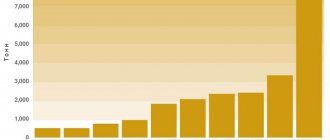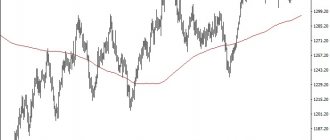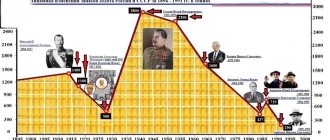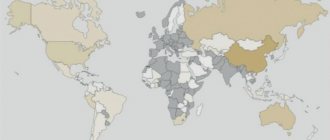Historically, in our society gold is the measure of value and wealth. Since ancient times, it has been used in mutual settlements between people, various communities and states. Therefore, everyone strives to possess it in as large quantities as possible.
By accumulating this precious metal, world powers form their gold reserves or gold reserves, which are the most important part of the gold and foreign exchange reserves - highly liquid assets designed to give stability to any financial system. What is especially important during times of crisis situations
, both in the country itself and in the global economy.
World trends and gold
To what level has the use of this precious metal reached today to form “airbags” in different countries of the world? The World Gold Council has released information that of the 33,790.8 tons of gold reserves held by all countries of the world (except Iran), the European Union accounts for 10,782.1 tons, or almost a third of the world's gold.
USA
The Great Depression was not only a period of severe trials for the economy of this country, but also the time when the basis of the state reserve of the country leading in gold reserves was laid. To do this, their own population had to hand over the available precious metal at a fixed and clearly reduced price. At the end of the almost predatory confiscation, the cost of an ounce increased from 20.66 to $35. The intensification of gold accumulation was each time stimulated by the next economic crisis.
But the highest figure was recorded during the period when World War II broke out. Then the size of the aurum reserve was huge and amounted to 20,205 tons. This volume could probably fit into five hundred freight cars. Over almost thirty years of existence of a financial system based on the “gold standard” (the so-called Bretton Woods system), when gold was spent to stabilize the dollar, the reserve decreased, and significantly: the reserve decreased to 9070 tons. The decline in reserve weight continued, and at the beginning of 2021 it “thinned” to 8133.5 tons.
Nevertheless, today the United States has the largest gold reserves in the world, accounting for 75% of the total government reserve. However, skeptics are not entirely sure that this figure is true: a complete and impartial verification of the contents of the storage facilities has not been carried out.
Airbags in Europe
Countries formulate their strategic reserves in different ways. Large and influential world powers occupy the first places in the list of countries in terms of reserves of the yellow metal. The figures showing the accumulated mass vary significantly, and the share of this metal in each state reserve may be different:
- Federal Republic of Germany. The leader of the European Union had 3,373.6 tons of aurum in its gold and foreign exchange reserves as of January 2021. The Germans have almost the same structure as the States: gold accounts for 70.2%. The maximum was observed in 1998 and amounted to 3,700.5 tons.
- Italian Republic. In terms of the reserves of gold coins and bars in the state reserve, this country took second place among European countries. Its “safety cushion” contains 2451.84 tons of gold, which is 67.5%, and this figure has remained unchanged for almost two decades. The highest figure was in 1969 - 2626.9 tons.
- The French Republic is the third country with the largest reserves of the precious metal in its treasury, with 2,436 tons of gold. This is 64.9% of the total reserve. The greatest accumulation of the precious metal was in 1966 and amounted to 4654.9 tons, when Charles de Gaulle headed for the exchange of dollar reserves for gold and refused to store it in the United States.
Why do you need a Gold Reserve (Gold Reserve)?
At one time, these reserves were used to determine how rich a country was because the amount of currency issued was linked to the amount of gold. Nowadays, gold is considered more of an alternative to storing large amounts of currency.
The trend of hoarding gold and using it as a measure of wealth stretches back centuries. There was a time when the global financial system operated under the so-called gold standard. It was a monetary system that directly linked the amount of gold a country held in reserve to the amount of currency it produced. The logic of this process was that if the gold was redeemed, then an equal value of currency could be issued for exactly that amount.
Although this monetary system has been replaced, countries continue the practice of holding reserves. Just like people keep money in a savings account in case they need it in the future. Many countries maintain a gold reserve as one of their financial assets.
Reliability and sovereignty
This yellow metal has long occupied its niche in people’s lives: it is needed not only to create jewelry masterpieces, but also to ensure the exchange rate, economic stability and even independence. Sometimes gold can also act as a universal means of payment - it cannot be blocked like a foreign currency account. World reserves are growing by country, and this trend continues.
The global financial system is built focused on one player - the United States of America:
- most transactions in the world are carried out in the currency of this particular country;
- about six dozen countries placed their gold and foreign exchange reserves or part of them in trust in the United States.
Special facilities at Fort Knox, the American Mint, West Point and the Federal Reserve Bank store 4500, 1400, 1700 and 400 tons of the precious metal, respectively. This state of affairs allows the United States to put pressure on the governments and policies of states that have entrusted almost part of the guarantees of their sovereignty to America. However, you should not assume that this is the only place where other people’s gold is stored.
For example, Germany put them in different baskets: it stored parts of its stock in the USA, England and France. In times of political crises, the issue of economic independence becomes the most pressing. In addition, the reliability of a business partner, whose debt is almost equal to the gross income (leading experts in the field of economic relations say this), gives rise to certain concerns.
And the fact that since 2013 Germany has been persistently working to return its gold “to its homeland.” During this time the following returned to the country:
- from the USA - 18.4%;
- from England - 0.2%;
- from France - 8.3% of the German gold reserves located there.
Now 47.9% of reserves are stored in Frankfurt am Main. The withdrawal process continues.
The example of Germany has become a clear illustration of the aggravation of American-European relations and the conflict of interests in the European Union itself. Many European countries have signed the Central Bank Gold Agreement. The fourth version of the SEC obliges its participants to refrain from selling significant volumes of the precious metal. By the way, it is very significant that the Republic of Turkey also withdrew its gold from the United States. There was not so little of it there - 220 tons.
Gold reserves of countries.
Top 10 largest gold reserves:
- USA - 8133.5 tons of gold;
- Germany - 3381 tons of gold;
- Italy - 2451.8 tons of gold;
- France - 2435.7 tons of gold;
- China - 1797.5 tons of gold;
- Russia – 1460.4 tons of gold;
- Switzerland - 1040 tons of gold;
- Japan - 765.2 tons of gold;
- Netherlands - 612.5 tons of gold;
- India - 557.7 tons of gold.
People's Republic of China
The largest holder of gold among East Asian states and a serious threat to US dominance. According to published data, in 2021 and 2021 the volume of national gold reserves amounted to 1842.6 tons . The share of all gold and foreign exchange reserves is only 2.4%. But it’s worth considering that this is not so little at all: in 2021, the PRC’s reserves were equal to $140 trillion.
China's activity in purchasing aurum in the gold market is growing, the Shanghai Gold and Exchange Exchange is increasing trading volumes. The Celestial Empire has significantly strengthened its position, becoming the leader in the production of this precious metal and one of its largest consumers.
Why is it better to store finances in gold?
There are a number of reasons why a gold reserve is seen as a good way to preserve capital. To begin with, holding gold is a good hedge if a particular currency loses its value. Consider, for example, the euro, which is the currency used by most of Europe. If this currency becomes worthless, those countries with gold reserves will still have some financial assets.
Another benefit of gold reserves is that they are easily convertible. Gold is a metal that can be exchanged for other valuables in most countries of the world. Therefore, states can use their gold reserves as collateral for loans. Reserves can also be used to satisfy debts, but this is rare. It is common knowledge that these reserves last for decades, and countries continue to replenish them.
Russia's strategic reserve
Geopolitical reasons and the desire to ensure the safety of its reserves in a situation where sanctions follow one after another, payments in dollars are limited, the state has set a course for replenishing the gold reserve and adjusting gold purchases. In addition, the share of American bonds in gold and foreign reserves decreased significantly: from 96 to 16 billion dollars.
Over the past ten years, expenses have quadrupled, and thanks to this, the “golden share” has increased tenfold. Well, in just three quarters of 2021, a third more was spent on the purchase of precious metals than in 2021. The pace of purchases is such that experts believe that in the foreseeable future, in just three years, Russia may become one of the three largest holders of gold. So far the Russian Federation is in fifth position.
There are two types of gold stored in the gold and foreign exchange reserves of the Russian Federation: bullion and monetary. In different years, the percentage of this component varied, as did its physical volume. The minimum quantity was noted in 1991 - 290 tons. At the beginning of 2021, the Central Bank announced a figure of 1,838.8 tons, and already in September it announced a much more impressive figure of 1,998.5 tons. This is 16.8% of the country's total gold and foreign reserves.
There are many tables that summarize data on gold and currency reserves of different countries. It is worth noting that the true size of the gold reserve is a state secret. Therefore, data on how much precious metal Russians have varies from source to source:
- officially announced 1999.95 tons;
- in data released by Bloomberg, it is 2170 tons;
- According to information from the World Gold Council, the presence of 1970 tons is confirmed, with a total value of 77.5 billion dollars.
Centuries passed, states were born and collapsed, but the role of the yellow precious metal remained unchanged. In an empire or republic, it was a measure of the country's security and power and helped reduce financial losses of the budget during periods of crisis. Is it any wonder that the gold reserves of the world's countries are steadily growing? If, of course, there are funds in the budget to purchase this metal.
What is GOLD RESERVE - meaning, definition in simple words.
In simple words the Gold Reserve or Gold Reserve is a kind of country’s stash that is stored in gold bars for a “rainy day.” As a rule, it is not spent unnecessarily and is used only when it is not possible to support the economy in other ways.
Gold in reserve
Modern registered government reserves of gold, concentrated in the Central banks of various countries and IMF reserves, amount to more than 32 thousand tons. The population has even larger amounts of gold in the form of jewelry and coins.
Gold reserves increase due to gold mining. About one percent of surface gold was mined in the first five years of the California Gold Rush.
Interestingly, according to scientists, all the gold on Earth is of cosmic origin. It is believed that gold ore deposits were formed about 4 billion years ago. It was then that a long golden meteor shower rained down on the Earth.
In the early 2000s, world reserves of mined gold amounted to about 150.4 thousand tons, which were distributed as follows:
- about 30 thousand tons in state central banks and international financial organizations;
- 79 thousand tons in jewelry - the leader and favorite in this case is precisely 750 gold;
- 17 thousand tons in electronics and dental products;
- 24 thousand tons in investment savings.
In 2009, the total world reserves of mined gold already amounted to 165 thousand tons. At $1,000 per troy ounce, the total value of that gold would be more than $5 trillion. About 20% of all onshore gold is held by central banks and official institutions as reserve assets.
Exchange-traded funds hold 1,750 tons of gold for private and non-private investors.











